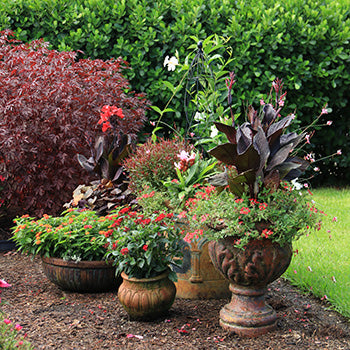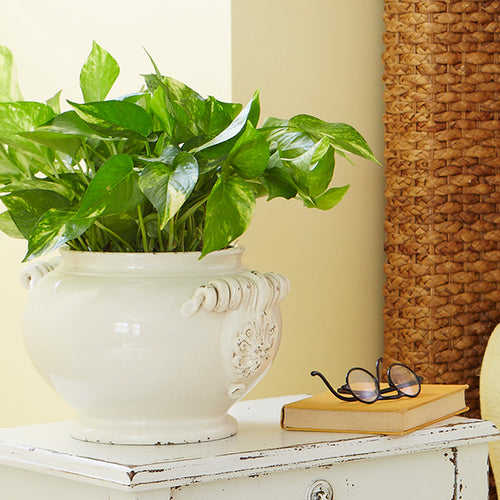By Karen Weir-Jimerson
When you walk into a garden center, you are greeted with a swath of colorful flowers: annuals and perennials. So what's the difference? Perennial flowers bloom during the spring, summer, and fall, depending on the species, and they come back the next year—and for years to come. Annuals bloom non-stop, from spring through fall, and then they fade.
 Perennial Plants
Perennial Plants
Here are the characteristics of perennial plants.
1. Perennials are long-lived.
They come back year after year, some for decades.
2. Perennials are zone specific.
Perennials, such as coneflower, left, will grow happily in the temperature zone they are adapted to. That’s why you’ll find some perennials that grow in Alaska but will not grow in Georgia, and vice versa. The zone information is on the plant tag.
3. Perennials can grow anywhere.
Perennials can grow in containers and window boxes as well as garden beds and landscapes. Compact-size perennials are specifically adapted to small spaces.
4. Perennials have light preferences.
Each perennial species has a specific light need. Some need to grow in the shade and others thrive best in full sun. And some can take a bit of each. The light requirement for the perennial will be listed on the plant tag.
5. Perennials have a designated bloom season.
These plants are engineered by Mother Nature to bloom at different times during the growing season. For example, Virginia bluebells flower in spring. Coneflowers bloom in spring and summer. Asters wait until fall. Each species blooms at the time it is supposed to—and they won’t bloom any other time.
Check out our Perennial Flowers Bloom Guide.
6. Perennials die back in winter.
In colder climates, most perennials die back (though there are some evergreen perennials). In warmer climates, they may just go dormant. But next spring, they pop back up and go through their seasonal bloom again, year after year. Like magic.
7. Perennials are easy care.
Since you only need to plant them once and enjoy them for years, perennials are the backbone of any garden or landscape. Examples of some easy-care perennials include hosta, phlox, and sedum.
8. Perennials are in it for the long haul.
For reliable color year after year, look for perennial flowers. These plants come back in spring, growing bigger and better with each succeeding season. If you want color all season, plant a mixture of spring-, summer-, and fall-flowering perennials.
 Annual Plants
Annual Plants
Here are the characteristics of annual plants.
1. Annuals have a one-season lifespan.
But they make up for it with their blooms! They flower like crazy for one season. At the end of their growing season, most will set seed. This is the life cycle of an annual: sprout, flower, set seed, die.
2. Annuals can grow anywhere.
In pots, window boxes, containers, garden beds, and landscapes, annuals, such as begonia, shown here, can be jammed in about anywhere and will bloom happily.
3. Annuals have light preferences.
Like perennials, annual plants also have specific light needs. Some love full hot baking sun, such as petunias and geraniums. Others prefer shade, such as begonias and impatiens.
4. Annuals bloom non-stop.
Annuals don’t have a season of bloom. Unlike perennials, annuals are like the marathon runners of the plant world, blooming hard and fast all season.
5. Annuals are done at the end of the season.
Once they hit the finish line of autumn, annuals are done. You need to remove them and replace them next spring. Although a few can survive mild winters.
6. Annuals are easy care.
Annuals add instant color to containers and garden beds. For the instant-gratification gardener, annuals excel. Examples of annuals include geraniums, marigolds, and petunias.
7. Annuals are instant gratification.
For quick color in beds, borders, or containers, annual flowers are the way to go. They start flowering at a young age and are in almost constant bloom from spring till fall. Most annuals will die after a hard frost in the fall, although a few, such as pansies, can survive milder winters.
Annual or Perennial? Telling Them Apart
If you are new to gardening it’s hard to tell the difference between an annual and a perennial, unless you know the species of plant. The plant tag will help you determine which plant is a perennial and which is an annual. There are some plant species that actually fall into both categories. For example, there are perennial and annual versions of rudbeckia. And in warm climates, Northern annuals may act like perennials, lasting for several seasons, because there is no frost to kill them.
In South Florida where we have our Trial Garden, for example, the following plants are perennial and grow for several seasons, but are annuals in cold-winter areas:
- Angelonia
- Caladium
- Crossandra
- Curcuma
- Evolvulus
- Gerbera daisy (Garvinea varieties)
- Heliconia
- Lantana
- Pentas
- Plumbago
- Shooting star
The Best of Both Worlds
You don’t have to choose between annuals and perennials. You can plant both and allow them to work in tandem in your garden and landscape to create the most beautiful displays of flowers and foliage. The annuals will carry the color show while your perennials come in and out of flower, creating an ever-changing tapestry of bloom.

















